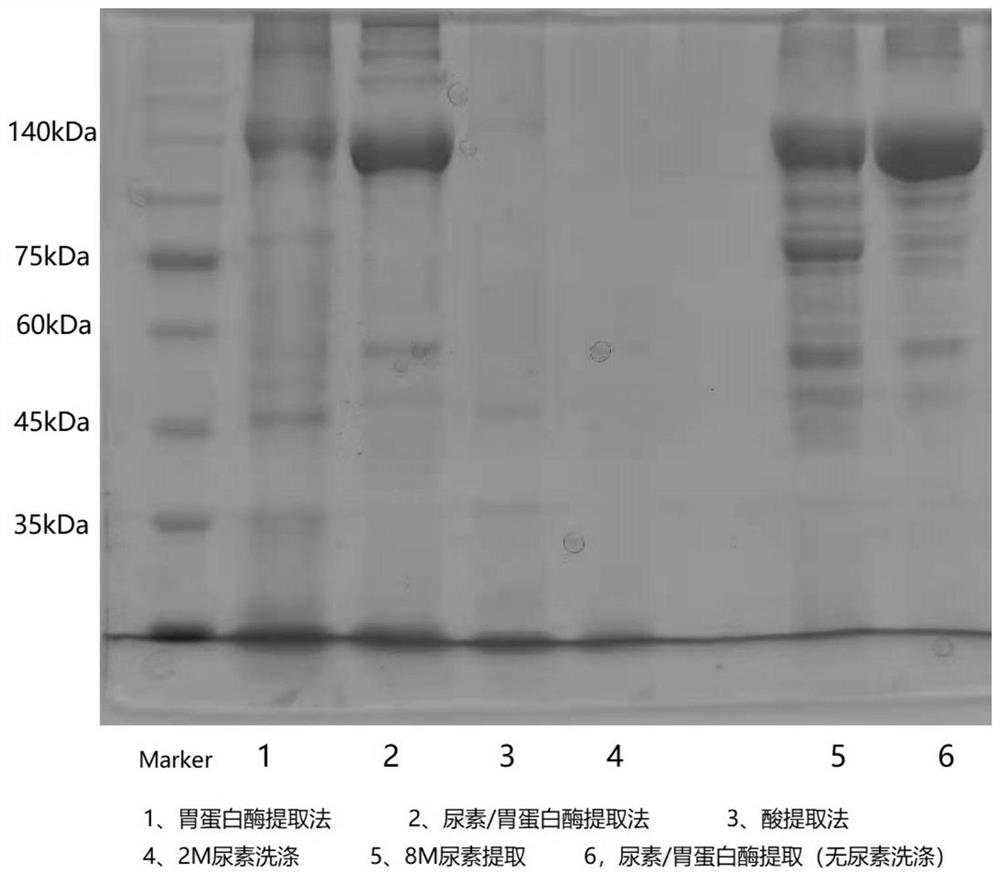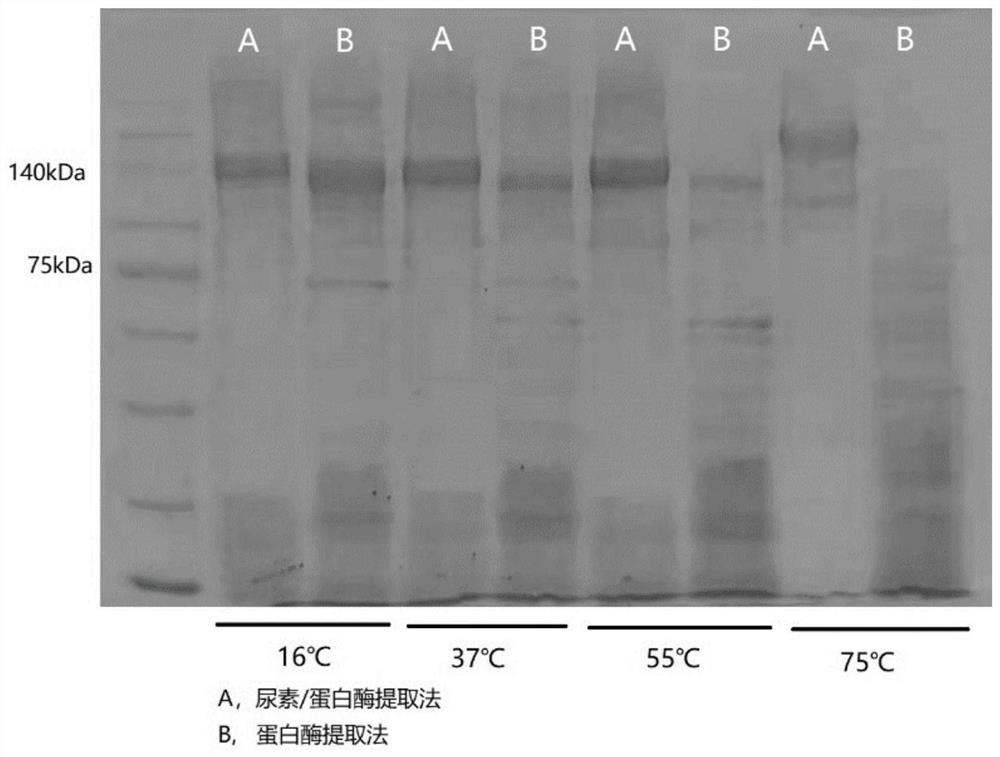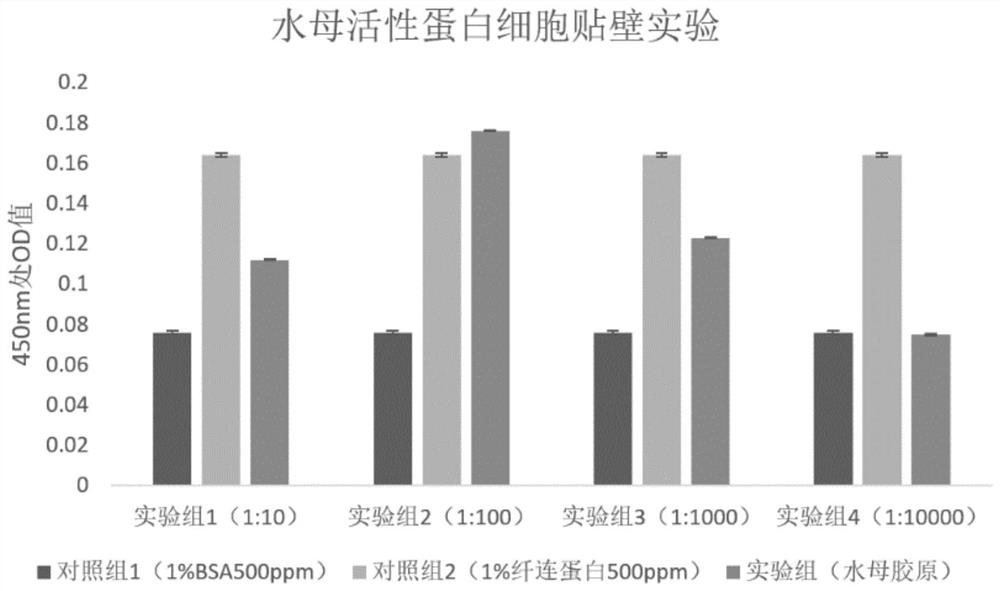Jellyfish active protein as well as preparation method and application thereof
A technology of active protein and jellyfish, which is applied in the field of jellyfish active protein and its preparation, can solve the difficult problems of jellyfish collagen quality control, uncontrolled degradation of collagen, and uncontrollable, so as to promote adherent growth and improve skin moisturizing Sexuality, the effect of repairing the skin barrier
- Summary
- Abstract
- Description
- Claims
- Application Information
AI Technical Summary
Problems solved by technology
Method used
Image
Examples
Embodiment 1
[0042] Embodiment 1 urea pepsin method
[0043] 1. Soak the sample in urea solution
[0044] Jellyfish skin (Rhopilema esculentum, jellyfish genus) was purchased from the aquatic market. Cut 10kg of pickled jellyfish into small pieces, wash them with tap water, and then soak them in pure water for several hours to remove salt. Add 1 gram of delipase (purchased from Shanghai Sangong), soak at 25° C. for 4 hours, and wash off the delipase. Divide the tissue block into 5 parts, 2kg each, add 4 liters of urea solution with a concentration of 1mol / L, 2mol / L, 3mol / L, 4mol / L, 5mol / L respectively, keep stirring at room temperature and low speed for 2 hours, in order to ensure the subsequent enzymatic To promote the reaction, urea needs to be removed, and at this time filter the tissue block with a filter cloth. The results showed that the tissue blocks melted to varying degrees after soaking in urea above 3mol / L, and the tissue loss was more when washing with urea. After soaking i...
Embodiment 2
[0049] Embodiment 2: pepsin method
[0050] Cut 10kg of pickled jellyfish into small pieces, wash them with tap water several times, and then soak them in pure water for several hours until the salinity is lower than 0.01. Add 1 gram of delipase, keep soaking at 25°C for 4 hours, and wash off the delipase. The following steps are carried out below 20°C. Add 0.5M citric acid to homogenize the material, then transfer to a stirring tank, add 10 mg / g pepsin (purchased from Shanghai Sangon Biology) solution for enzymatic digestion, and keep stirring at 16°C for 12 hours. After digestion, centrifuge at 17,000g for 30 minutes to separate undigested tissue pieces, neutralize the separated supernatant to pH 7.0 with sodium hydroxide, and then centrifuge at 17,000g for 20 minutes to collect the collagen gel precipitate. The collagen was then dissolved with 0.05% citric acid, then the supernatant was adjusted to neutral, and the gel precipitate was collected by centrifugation, and the ...
Embodiment 3
[0051] Embodiment 3: acid extraction process
[0052] Cut 10kg of pickled jellyfish into small pieces, wash them with tap water several times, and then soak them in pure water for several hours until the salinity is lower than 0.01. Add 1 gram of delipase, keep soaking at 25°C for 4 hours, and wash off the delipase. The following steps are carried out below 20°C. Add 0.5M citric acid to homogenize the material, transfer it to a stirring tank, and keep stirring at a slow speed for 12 hours at 16°C. After digestion, centrifuge at 17,000g for 30 minutes to separate undigested tissue pieces, neutralize the separated supernatant to pH 7.0 with sodium hydroxide, and then centrifuge at 17,000g for 20 minutes to collect the collagen gel precipitate. The collagen was then dissolved with 0.05% citric acid, then the supernatant was adjusted to neutral, and the gel precipitate was collected by centrifugation, and the steps from dissolution to neutralization were repeated twice. Swell t...
PUM
 Login to View More
Login to View More Abstract
Description
Claims
Application Information
 Login to View More
Login to View More - R&D Engineer
- R&D Manager
- IP Professional
- Industry Leading Data Capabilities
- Powerful AI technology
- Patent DNA Extraction
Browse by: Latest US Patents, China's latest patents, Technical Efficacy Thesaurus, Application Domain, Technology Topic, Popular Technical Reports.
© 2024 PatSnap. All rights reserved.Legal|Privacy policy|Modern Slavery Act Transparency Statement|Sitemap|About US| Contact US: help@patsnap.com










